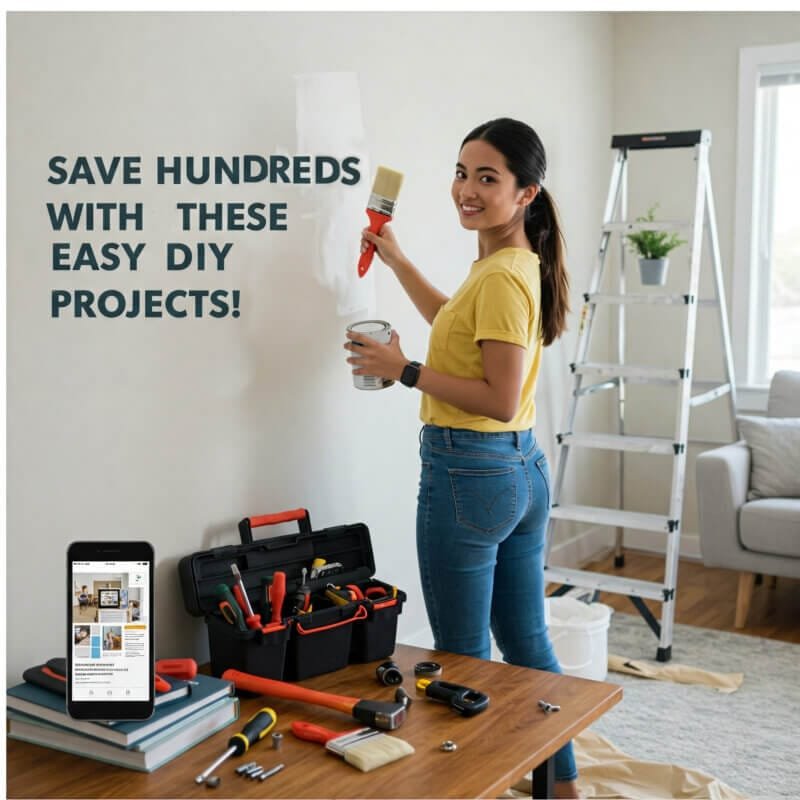12 Easy DIY Projects to Save Hundreds of Dollars: Beginner-Friendly Home Repairs
Hiring a professional for home repairs can cost hundreds—or even thousands—of dollars. But what if you could tackle those projects yourself with just a few basic tools and a little know-how? In this guide, we’ll show you 12 easy DIY projects to save money that even a beginner can handle. Plus, we’ll cover the cheap tools every homeowner should have to get started. Let’s dive in and start saving!
Essential Tools for DIY Beginners
Before we get into the projects, let’s talk about the tools you’ll need. You don’t need a fancy, expensive toolset to get started. Here’s a list of basic, affordable tools that can handle most beginner DIY tasks:
- Hammer ($10−20): For driving nails and light demolition.
- Screwdriver Set ($10−15): A set with flathead and Phillips heads will cover most screws.
- Adjustable Wrench ($10−15): Perfect for tightening nuts and bolts.
- Tape Measure ($5−10): Essential for accurate measurements.
- Utility Knife ($5): Great for cutting materials like drywall or carpet.
- Level ($10−15): Ensures your shelves, pictures, and fixtures are straight.
- Cordless Drill ($30−50): A versatile tool for drilling holes and driving screws.
- Pliers ($10−15): Useful for gripping, bending, and cutting wires.
- Stud Finder ($10−20): Helps locate wall studs for secure mounting.
- Paintbrushes and Rollers ($10−20): For painting walls, furniture, and more.
With these cheap tools for DIY projects, you’ll be ready to tackle the projects below—and many more!
If you’re new to DIY projects or prefer the convenience of a ready-made solution, pre-configured tool kits are an excellent option. These kits come neatly packaged with all the essential tools you’ll need to tackle most beginner-friendly tasks. Entry-level sets start at around $60, offering basic tools like hammers, screwdrivers, and wrenches while more advanced kits are priced at $100 or more and include items like cordless drills, pliers, and measuring tapes. These kits are designed to save you time and effort, ensuring you have everything you need to get started without the hassle of piecing together a collection yourself.
But I Don’t Know How to Do Any of This
If you’re feeling overwhelmed or unsure where to start, you’re not alone. Many homeowners feel the same way, but the good news is that learning basic DIY skills is easier than ever. One of the best resources at your fingertips is YouTube. With millions of free, step-by-step tutorials, you can learn how to tackle almost any home repair or improvement project. Whether it’s fixing a leaky faucet, patching drywall, or installing a ceiling fan, there’s a video out there to guide you through the process.
As a homeowner, unexpected repairs and maintenance tasks are inevitable. Instead of immediately calling a professional—and paying hundreds of dollars—taking the initiative to do some of the work yourself can lead to significant savings. Over time, these savings add up, potentially saving you thousands of dollars a year.
Not only will you save money, but you’ll also gain valuable skills and confidence. The first time you successfully complete a DIY project, you’ll feel a sense of accomplishment—and you’ll be better prepared to handle future repairs. Plus, you’ll have the satisfaction of knowing you did it yourself.
So, the next time something breaks or needs updating, don’t panic. Grab your tools, pull up a YouTube tutorial, and give it a try. We’ve even taken the liberty to link to easy to follow YouTube videos that walk you through each of the projects outlined below. You might surprise yourself with what you can accomplish!
12 Easy DIY Projects to Save Money
Here are 12 home repairs and improvements that you can easily do yourself, saving hundreds of dollars in the process:
1. Patch Small Holes in Drywall
Cost to Hire a Pro: $100−200
DIY Cost: $10−20
Small holes from nails or screws are easy to fix with a drywall patch kit and some spackle. Sand the area smooth, apply the patch, and paint over it for a seamless finish.
2. Paint a Room
Cost to Hire a Pro: $200−500
DIY Cost: $50−100
Painting is one of the easiest ways to refresh a room. All you need is paint, rollers, brushes, and painter’s tape. Prep the walls by cleaning them and covering floors with drop cloths.
3. Replace a Faucet
Cost to Hire a Pro: $150−300
DIY Cost: $50−100
Replacing a leaky faucet is simpler than it looks. Turn off the water supply, disconnect the old faucet, and install the new one using an adjustable wrench. Follow the manufacturer’s instructions for a secure fit.
4. Install a Ceiling Fan
Cost to Hire a Pro: $200−400
DIY Cost: $100−150
If you already have wiring in place, installing a ceiling fan is straightforward. Turn off the power, mount the bracket, and connect the wires according to the instructions. Use a level to ensure it’s straight.
5. Caulk Windows and Doors
Cost to Hire a Pro: $100−200
DIY Cost: $10−20
Caulking gaps around windows and doors improves energy efficiency and prevents drafts. Use a caulk gun to apply a smooth bead, then smooth it with your finger or a caulk tool.
6. Hang Shelves
Cost to Hire a Pro: $100−300
DIY Cost: $20−50
Hanging shelves is a great way to add storage and style to your home. Use a stud finder to locate wall studs, then secure the brackets with screws. Place the shelf on top and secure it.
7. Replace a Light Fixture
Cost to Hire a Pro: $150−300
DIY Cost: $50−100
Turn off the power, remove the old fixture, and connect the wires of the new fixture (black to black, white to white, and ground to ground). Secure the fixture to the ceiling or wall.
8. Unclog a Drain
Cost to Hire a Pro: $100−200
DIY Cost: $5−10
Skip the plumber and use a plunger or drain snake to clear clogs. For stubborn clogs, try a mixture of baking soda and vinegar followed by hot water.
9. Install a Smart Thermostat
Cost to Hire a Pro: $150−300
DIY Cost: $100−200
Most smart thermostats come with step-by-step instructions. Turn off the power, remove the old thermostat, and connect the wires to the new one. Mount it on the wall and follow the setup guide.
10. Replace Cabinet Hardware
Cost to Hire a Pro: $100−200
DIY Cost: $20−50
Updating cabinet knobs and pulls is an easy way to refresh your kitchen or bathroom. Use a screwdriver to remove the old hardware and install the new pieces.
11. Seal a Driveway or Deck
Cost to Hire a Pro: $200−500
DIY Cost: $50−100
Sealing your driveway or deck protects it from weather damage. Clean the surface, apply the sealant with a roller or brush, and let it dry according to the instructions.
12. Install a Programmable Doorbell
Cost to Hire a Pro: $150−300
DIY Cost: $50−100
Many smart doorbells are designed for easy DIY installation. Turn off the power, connect the wires, and mount the doorbell using the included screws. Follow the app instructions for setup.
Tips for Successful DIY Projects
- Start Small: Begin with simple projects to build confidence.
- Watch Tutorials: YouTube is a goldmine for step-by-step DIY guides.
- Measure Twice, Cut Once: Double-check measurements to avoid mistakes.
- Safety First: Wear protective gear and turn off power when working with electricity.
- Ask for Help: Don’t hesitate to ask a friend or family member for assistance.
Final Thoughts: Save Money and Gain Skills
DIY projects aren’t just a way to save money—they’re an opportunity to learn new skills and take pride in your home. With the basic tools listed above and a little patience, you can tackle these 12 easy projects and save hundreds of dollars.
So, grab your toolbox and get started! For more money-saving tips and DIY guides, bookmark our site and subscribe to our newsletter. Happy DIY-ing!

